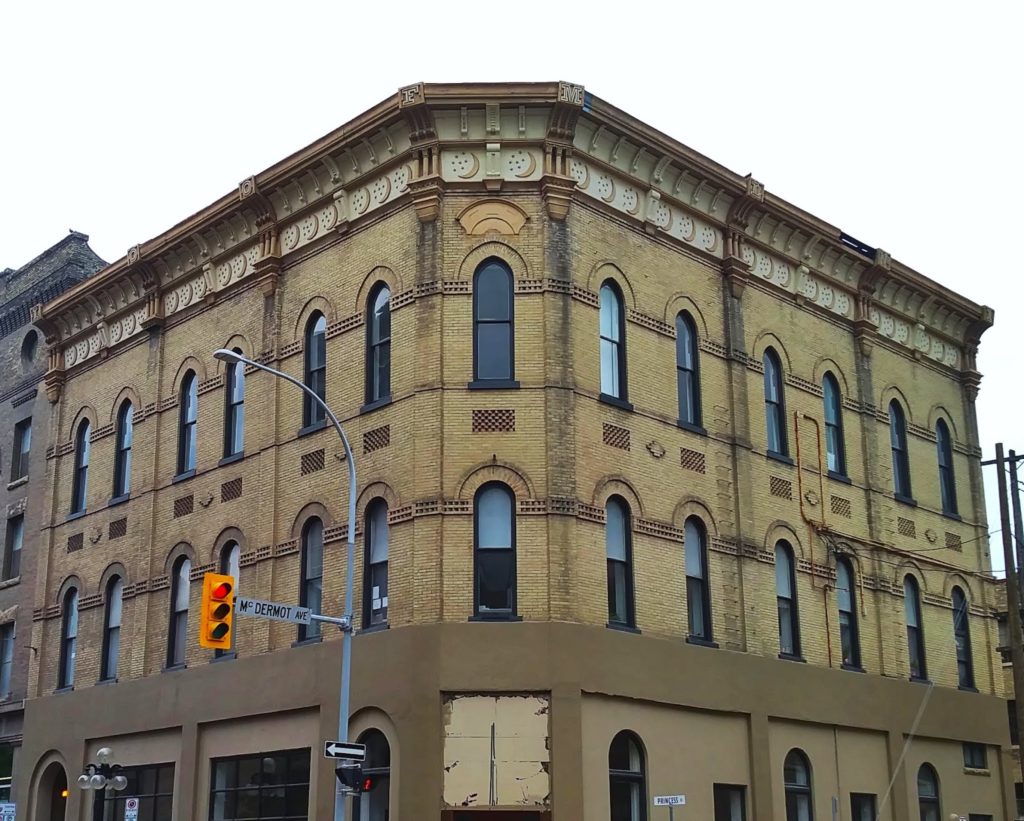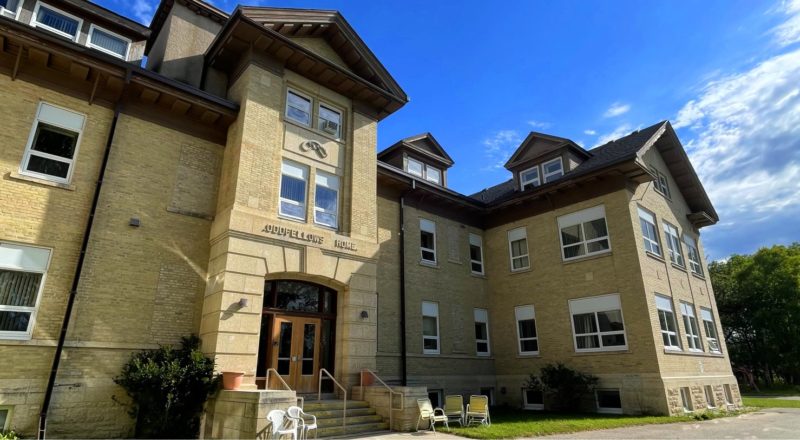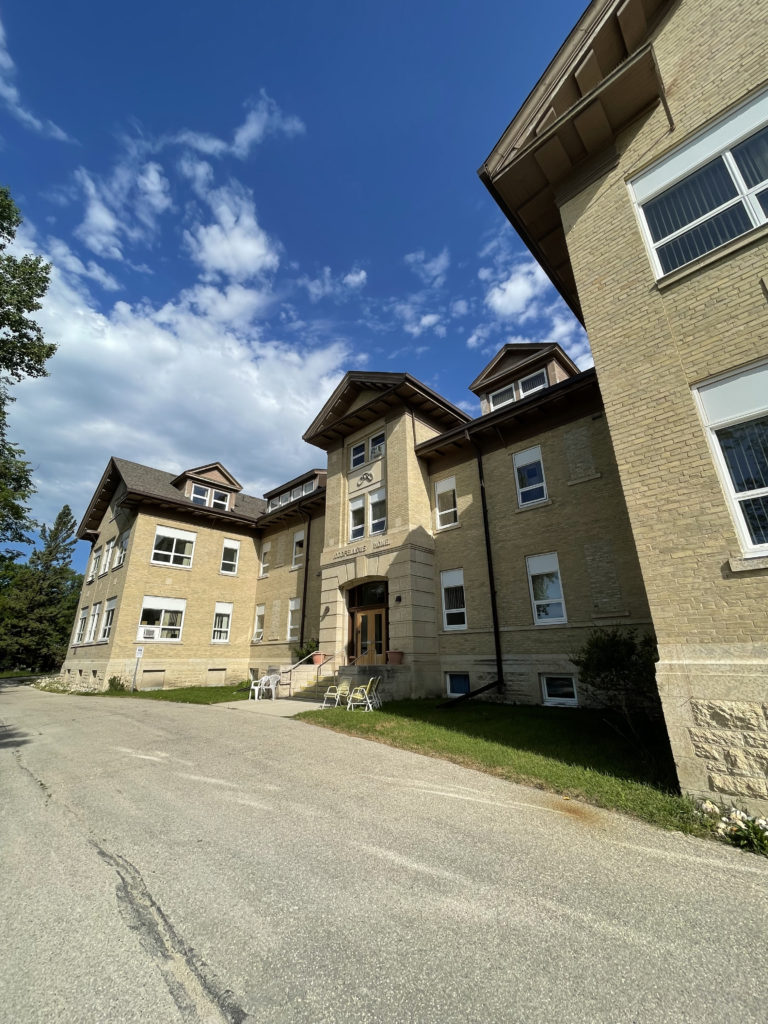
/ Blog
October 21, 2022
A Community That Cares: The Odd Fellows Home
Charleswood, the “Suburb Beautiful”, was incorporated as a rural municipality in 1913. It was a growing community; the one room log school house had just been replaced by a more impressive red brick structure, and people were setting their sights on the neighbourhood as an escape from urban life. The area was also appealing to the Independent Order of Odd Fellows, who would build a large, stately building in the area. Known as the Odd Fellows Home, the facility on the southern bank of the Assiniboine River has served the community for nearly 100 years. During that century, new developments have crept closer to the historic Home, putting it at risk of damage or worse, demolition. Fortunately, the residents of Charleswood and the heritage community see the value of the building, and have fought long and hard to ensure this part of our heritage is properly protected.
Although their exact origins are a mystery, the Independent Order of Odd Fellows (IOOF) is an international fraternal order of Odd Fellowship. It is speculated that the peculiar institution dates back to the mid-1600s, with the first official recorded meeting being held in 1745 in England before spreading to the western world in the 1800s. Comprised of common labourers, the men pooled their resources to help one another and the wider community in times of hardship. A non-sectarian and non-political organization, the IOOF provide fellowship to their members while aspiring to do good in their communities. Their motto is “Friendship, Love and Truth” with the objective to “Improve and Elevate the Character of Mankind.”
The IOOF arrived in Canada in 1843, opening the Prince of Wales Lodge No. 1 in Montreal, and spreading to Manitoba by 1873. The first IOOF lodge in Winnipeg was founded in 1873, and alongside their female counterparts, the Rebakahs, the IOOFs continued their agenda of mutual assistance. Several IOOF buildings still exist in Winnipeg: the Odd Fellows Hall at 72 Princess Street, the Odd Fellows Temple at 78 the Promenade, and the Odd Fellows Home at 4025 Roblin Boulevard.

The Independent Order of Odd Fellow Hall at 72 Princess Street in Winnipeg in 2018.
Source: Naomi Brien for Heritage Winnipeg.
It was the summer of 1916 when the IOOF began their search for a Winnipeg property, hoping to develop a large home for elderly members and their spouses, as well as orphaned children of deceased members. The vast, vacant property in the Rural Municipality of Charleswood fit the needs of the structure’s intent. Winnipeg architect J. H. G. Russell, known for some of Winnipeg’s finest buildings, was selected to design the housing project through a contest. However, construction of the 40 bed facility was halted in 1917, following the beginnings of site excavation. The delay allowed for funds to accumulate, resulting in the possibility of a more expansive facility costing more than the initially anticipated $30-40,000.
The second attempt at construction, resulting in the present-day Odd Fellows Home at 4025 Roblin Boulevard, began in 1922. The cornerstone was laid on July 15th of that year, with a ceremony officiated by Grand Secretary B.D. Deer. Guests came from as far as Neepawa and Dauphin to speak at the ceremony. It was the 58th home built by the IOOF, but only the second one in Canada (the first was in Toronto). The contractor was Sveinn Brynjolfsson, an Icelandic gentleman who had arrived in Winnipeg in the 1890s. Brynjolfsson had previously helped build the International Order of Good Templars Hall at 635 Sargent Avenue, among other buildings, and had also served as Vice-Consul for Denmark in Winnipeg.
Once completed, the official opening was attended by approximately 850 people on March 13th, 1923. The opening ceremonies were dedicated to Lucian J. Eastin (IOOF Grand Sire of St. Joseph, Missouri) and notable speakers included Lieutenant-Governor James A. M. Aikins. The Home was significantly larger than Russel’s original plans for the building. Spreading 140 feet by 50 feet with two south projecting wings, the Home could accommodate up to 70 people. Inspired by Georgian Revival architecture, the building had a symmetrical façade with an elaborate centralized entrance. The total cost of construction was $125,000 with an additional $25,000 for furnishings.
The basement of the building held two large playrooms for the children, a boiler room, the janitor’s office, and laundry and storage rooms. On the ground floor, there were two large sunrooms, a dining room, kitchen, pantry, office, reception rooms, and 13 bedrooms as well as a matron’s quarters. Above, on the second floor, were an additional seven bedrooms, two wards with five beds, two study rooms, an assembly hall, and a hospital ward. This hospital ward was isolated from the rest of the building, with separate beds and a bathroom. The attic remained unfinished at the time of completion but could be altered to accommodate another 20 children.
By 1932, there were 30 residents in the home: 23 orphans, and seven aged members. A year earlier, some of the children in the home participated in a parade featuring a model of the Odd Fellows Home. Public awareness and engagement were always a key part of life at the Odd Fellows Home, and concerts, benefits, and other events were held there. The orphans in the Home attended public school, and there was no age limit after which young residents would have to leave the home. One resident was actually a university student and left the Home after receiving his bachelor of arts.
Over the years, the childcare system across Canada changed – shifting away from orphanages to the foster care system, and the Odd Fellows Home transitioned into a seniors home by the 1950s. For much of this time, the Rebakah’s contributed to the upkeep of the building. Funds were raised to add commercial laundry to the building in the 1950s, and an elevator in 1966. Members of the Rebekah Lodge would, on occasion, prepare meals for the residents and organized weekly entertainment and treats. Students from the Chapman School would also occasionally provide entertainment to the building’s residents, and in fact, used part of the Home when the Chapman School burned down in 1943.
The Winnipeg Regional Health Authority began providing funding to the Home in the later part of the 20th century, though the Odd Fellows remained the owners and operators of the building. When provincial funding was withdrawn in 1997, the Odd Fellows Home was forced to close. Since this, the building has been reconfigured to accommodate seven studio apartments and 25 single bedroom suites. Following the completed renovations, the historical structure reopened in 2001 as an assisted living facility known as Assiniboine Links. Additionally, a private residential subdivision was later constructed between the building and the Assiniboine River.
The Odd Fellows Home has recently received significant attention due to the proposed new 199 unit multi-family building in the southeast corner of the property, near the historic building. After owning the property for over a century, the IOOF can no longer afford to stay and have found a developer interested in buying the property, which includes the Home. Charleswood residents were concerned about the increased traffic a large housing structure would bring and the green space that would be lost. The heritage community was equally concerned, worrying that construction could damage the Home and lead to its eventual demolition. Also, the new development’s proposed design, height and massing was insensitive to the site and the existing community. While the Assiniboia Community Committee approved the new development’s rezoning application in January 2022, it denied the variance requests. Additionally, Councillor Kevin Klein, with the support of the area residents and Heritage Winnipeg, recommended a motion to nominate the Odds Fellows Home for a heritage designation, which would prevent the historic structure from being demolished in the future.
Heritage Winnipeg, which champions the thoughtful conservation of heritage buildings that contribute positively to their community, worked with the community to support their efforts to have the building designated. Heritage Winnipeg was also working to ensure any additional development on the site surrounding the Odd Fellows Home was done in a manner that is respectful to the historic building, established landscape and current community. As a result, the Odds Fellows Home was officially nominated for a heritage designation at the Standing Policy Committee on Property and Development, Heritage and Downtown Development meeting on June 14th, 2022. The nomination was then appealed by the property’s developer. Now it is up to the Historic Buildings and Resources Committee to come back with their recommendation to the Standing Policy Committee on Property and Development, Heritage and Downtown Development Committee as to whether or not the building should be officially designated.
And while the designation process slowly moves forward, another victory for the Odds Fellows Home and the Charleswood community was won on September 15, 2022. Due to the vast opposition to the development plan by the community, the issue was referred to the Manitoba Municipal Board, a quasi-judicial tribunal tasked with resolving property assessment appeals. Three days of hearings were held in June and July of 2022, with numerous speakers, both professionals and community members – including Heritage Winnipeg – presenting their opinions on the planned new development. After a nervous waiting period, the Board found that “the character and quality features of the area would drastically change with a higher density, RMF-L zoning development” and recommended that any new development be limited to three storeys and 156 units, including the Odds Fellows Home. Further, the Board’s recommendations were to completely reject the current development proposal, which had been previously approved by City Council. Now the developer cannot make another application for one year. Also, if a new development proposal for this site does go forward, the pending heritage designation will give more power to the City and the community to demand the better incorporate of the existing historic structure and green space, while respecting the surrounding residential community. Bravo to everyone who came out and spoke in support of stopping the proposed development!
While adaptive reuse of heritage buildings and densification of historic neighbourhoods are imperative to keeping our communities viable and vibrant, one should never be accomplished to the detriment of the other. The Odds Fellows Home has the potential to be the centerpiece of a desirable development that celebrates heritage and is respectful of the character of the surrounding community – if given the thoughtfulness it deserves. Heritage Winnipeg is hopeful that the impending designation of the Home and the result of the Manitoba Municipal Board hearing will send a clear message to developers that their profit can not come at a cost to the existing community. Our communities and their heritage deserve to be protected and celebrated!
THANK YOU TO THE SPONSOR OF THIS BLOG POST:

Written by Heritage Winnipeg.
SOURCES:
Research provided by the Rebekahs | Thank you!
4025 Roblin Boulevard Potential Development | Landmark Planning & Design
Appeal - Historical Resources By-law No. 55/2014 - 4025 Roblin Boulevard | City of Winnipeg
Assiniboine Links Assisted Living | A & O: Support Services for Older Adults
Charleswood History | Charleswood Historical Society
Historical Resources By-law No. 55/2014 - 4025 Roblin Boulevard | City of Winnipeg
Institutions of Fraternal Love | Winnipeg Evening Tribune, 1932-10-10, page 6
The Mysterious Independent Order Of Odd Fellows Hall | Heritage Winnipeg
Odd Fellows Home Dedicated in Charleswood | Winnipeg Evening Tribune, 1923-03-13, page 1-2
Odd Fellows Home Depicted in Parade | Winnipeg Tribune 1931-09-24, page 9
Our Mission | The Sovereign Grand Lodge Independent Order of Odd Fellows
Winnipeg Tribune Files













